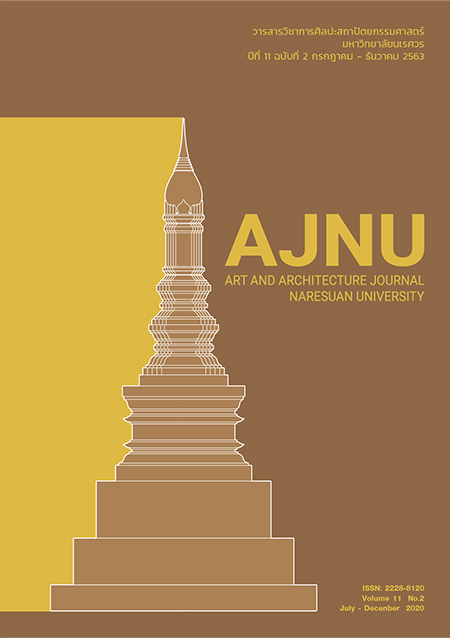Space in everyday life of retired japanese long stay in the city of Chiang mai
Main Article Content
Abstract
From the expansion of the elderly society in Japan. Japanese Government has a policy to encourage the retirees to travel to foreign countries for long stay. Chiang Mai is another destination for long stays due to convenient travel, warm climates and cheaper living costs than Japan. In addition to the above factors, there are other factors that result in Japanese retirees choosing to long stay, which is the space factor. Especially the area that Japanese retirees choose to use in the Everyday life. “The Everyday life space” in this article is the theoretical framework that arises from the merging. Martin Heidegger's Phenomenology and Production of space of Henri Lefebvre, which is a concept used to describe the relationship between people, space and spatial practice that happens in the Everyday life. This article introduces the concept of Everyday life space to describe the usage of the area of the Japanese retirement group and the characteristics of space that they were used in the city, both in city area, district area and the architectural space, to look for the use of the area of the Japanese retirement group who long stay in the focuses area and the characteristics of space and
architecture that encourages the use in everyday life. Including identifying the relationship between the Being and the Everyday life of the sample group through spatial practice. Which resulted in Japanese retirees choosing to live long stay happily, and causing the neighborhood of Japanese retirees in Chiang Mai
Article Details
References
เฉลิมพล แจ่มจันทร์ และ อรไท โสภารัตย์. (2555). การพำนักระยะยาวของคนญี่ปุ่นในจังหวัดเชียงใหม่:การวิเคราะห์ปัจจัยกำหนดในช่วงก่อนและหลังการพำนัก. วารสารญี่ปุ่นศึกษา, 29(1), 26-34.
นรีนุช ดำรงชัย. (2560). ญี่ปุ่นหลังสงครามโลกครั้งที่สองกับการเปลี่ยนผ่านทางความคิดและค่านิยมภายใต้แนวคิด”เซดะริอง. วารสารเครือข่ายญี่ปุ่นศึกษา, 7(1), 89-92.
ปิยลดา เทวกุล ทวีปรังษีพร, หม่อมหลวง. (2554). คำ ความคิด สถาปัตยกรรม (พิมพ์ครั้งที่ 1). กรุงเทพมหานคร: บริษัท ลายเส้น พับบลิชชิ่ง จำกัด, 94-98.
ปัญจมา แผลงศร. (2556). การสร้างปฏิสัมพันธ์ระหว่างคนญี่ปุ่นที่พำนักระยะยาวกับคนไทยในท้องถิ่น กรณีศึกษา จ.เชียงใหม่ (ศิลปศาสตรบัณฑิต). มหาวิทยาลัยเชียงใหม่, เชียงใหม่.
พันธ์ทิพย์ จงโกรย และชนมณี ทองใบ. (2557). รูปแบบการกระจายเชิงพื้นที่ของพื้นที่เมืองในประเทศไทย. วารสารเกษตรศาสตร์ (สังคม), 35(1), 30-44.
สันต์ สุวัจฉราภินันท์. (2550). ปัญหาและความรู้ของที่ว่าง : ศึกษาจากทฤษฎีที่ว่าด้วยที่ว่างของฮองรี เลอแฟร์ และมิเชล เดอ เซอร์โต. ใน ธเนศ วงศ์ยานนาวา (บรรณาธิการ). วารสารรัฐศาสตร์สาร : รัฐศาสตร์ธรรมศาสตร์ 60 ปี/ รัฐศาสตร์สาร 30 ปี (เล่ม 2), 88-137.
สุดปารถนา ดวงแก้ว. (2555). การท่องเที่ยวแบบพำนักระยะยาวในอำเภอเมือง จังหวัดเชียงใหม่ : กรณีศึกษาการตั้งชุมชนและการปรับตัวของชาวญี่ปุ่นวัยเกษียณ (ศิลปศาสตรมหาบัณฑิต). มหาวิทยาลัยธรรมศาสตร์, กรุงเทพมหานคร.
สุดปารถนา ดวงแก้ว. (2558). การปรับตัวทางสังคมและวัฒนธรรมของคนญี่ปุ่นวัยหลังเกษียณที่พำนักระยะยาวในจังหวัดเชียงใหม่ ประเทศไทย. สถาบันเอเชียตะวันออกศึกษาฯ มหาวิทยาลัยธรรมศาสตร์, กรุงเทพมหานคร.
Heidegger, M. (1962). Being and Time. John Macquarrie and Edward Robinson. (trans). New York: Harper & Row.
Lefebvre, H. (1991). The Production of Space. Malden: Blackwell.


